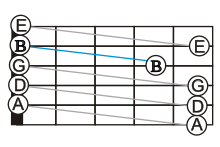| All fifths | |
|---|---|
 The consecutive open-notes of all-fifths tuning are each spaced seven semitones apart on the chromatic circle. | |
| Basic information | |
| Aliases | Perfect-fifths tuning |
| Interval | Perfect fifth |
| Semitones | 7 |
| Example(s) | C-G-d-a-e'-b' or G'-D-A-e-b-f♯' |
| Advanced information | |
| Other instruments | violin, cello, mandolin, tenor banjo |
| Repetition | No |
| Advantages | Wide range; natural for concert stringed-instrument music |
| Disadvantages | Difficult to play standard-guitar music |
| Left-handed tuning | All-fourths tuning |
| Associated musician | |
| Guitarist | Carl Kress |
 | |
| Carl Kress played jazz with all-fifths tuning. | |
| Regular tunings (semitones) | |
| Trivial (0) | |
| Minor thirds (3) | |
| Major thirds (4) | |
| All fourths (5) | |
| Augmented fourths (6) | |
| New standard (7, 3) | |
| All fifths (7) | |
| Minor sixths (8) | |
| Guitar tunings | |


Among guitar tunings, all-fifths tuning refers to the set of tunings in which each interval between consecutive open strings is a perfect fifth. All-fifths tuning is also called fifths, perfect fifths, or mandoguitar.[1] The conventional "standard tuning" consists of perfect fourths and a single major third between the g and b strings:
- E-A-d-g-b-e'
All-fifths tuning has the set of open strings
- C-G-d-a-e'-b' or G'-D-A-e-b-f♯',
which have intervals of 3 octaves minus a half-step between the lowest and highest string. The conventional tuning has an interval of 2 octaves between lowest and highest string.
All-fifths tuning is a tuning in intervals of perfect fifths like that of a mandolin or a violin. It has a wide range. It was used by jazz guitarist Carl Kress in the form
- B♭'-F-c-g-d'-a'.[2]
- ^ Sethares (2001, "The mandoguitar tuning" 62–63): Sethares, Bill (2001). "Regular tunings". Alternate tuning guide (PDF). Madison, Wisconsin: University of Wisconsin; Department of Electrical Engineering. pp. 52–67. 2010 Alternate tuning guide, including a revised chapter on regular tunings. Retrieved 19 May 2012.
- ^ Page 92. Richard Lieberson, "Swing guitar: The acoustic chordal style", pages 89-112. The Guitar in Jazz: An Anthology, Edited by James Sallis. 1996. 978-0-8032-4250-0